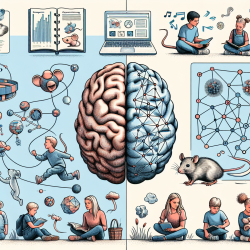Introduction
In the ever-evolving field of speech-language pathology, understanding the intricate workings of the brain is paramount to improving therapeutic outcomes for children. A recent study titled "Normal aging in mice is associated with a global reduction in cortical spectral power and network-specific declines in functional connectivity" provides groundbreaking insights into how aging affects brain connectivity. While the study focuses on mice, its implications for child development and therapy are profound.
The Study: Key Findings
The research utilized advanced mesoscale imaging techniques to observe neuronal activity in young and aged Thy1-GCaMP6f mice. The findings revealed two significant trends:
- A global decline in spontaneous cortical activity across a wide frequency range (0.01–4 Hz) as mice age.
- Network-specific deterioration in functional connectivity, particularly in somatomotor, cingulate, and retrosplenial nodes.
These changes were correlated with behavioral declines, suggesting that the observed neuronal alterations may be linked to age-related functional deterioration.
Implications for Child Development
While the study focuses on aging, the insights gained can be applied to understanding developmental processes in children. Here's how practitioners can leverage these findings:
- Enhancing Therapeutic Approaches: By understanding the importance of functional connectivity, therapists can design interventions that target specific brain networks, potentially improving outcomes in children with developmental delays.
- Monitoring Developmental Progress: The study highlights the role of spontaneous cortical activity in behavior. Practitioners can use this knowledge to better assess and monitor developmental progress in children.
- Encouraging Further Research: The study serves as a call to action for further research into how brain connectivity changes during development and how these changes impact language and cognitive skills.
Data-Driven Decisions in Therapy
Data-driven decision-making is crucial in speech-language pathology. By incorporating findings from this study, practitioners can make informed decisions that are backed by scientific evidence. This approach not only enhances the effectiveness of therapy but also ensures that interventions are tailored to the unique needs of each child.
Conclusion
The study on mice aging and brain connectivity offers valuable insights that can be translated into therapeutic practices for children. By understanding the role of functional connectivity and cortical activity, practitioners can enhance their skills and improve outcomes for their young clients. As we continue to unravel the complexities of the brain, the potential for creating positive developmental outcomes is immense.
To read the original research paper, please follow this link: Normal aging in mice is associated with a global reduction in cortical spectral power and network-specific declines in functional connectivity.










